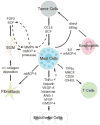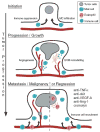Mast cells in tumor growth: angiogenesis, tissue remodelling and immune-modulation
- PMID: 19233249
- PMCID: PMC2731828
- DOI: 10.1016/j.bbcan.2009.02.001
Mast cells in tumor growth: angiogenesis, tissue remodelling and immune-modulation
Abstract
There is a growing acceptance that tumor-infiltrating myeloid cells play an active role in tumor growth and mast cells are one of the earliest cell types to infiltrate developing tumors. Mast cells accumulate at the boundary between healthy tissues and malignancies and are often found in close association with blood vessels within the tumor microenvironment. They express many pro-angiogenic compounds, and may play an early role in angiogenesis within developing tumors. Mast cells also remodel extracellular matrix during wound healing, and this function is subverted in tumor growth, promoting tumor spread and metastasis. In addition, mast cells modulate immune responses by dampening immune rejection or directing immune cell recruitment, depending on local stimuli. In this review, we focus on key roles for mast cells in angiogenesis, tissue remodelling and immune modulation and highlight recent findings on the integral role that mast cells play in tumor growth. New findings suggest that mast cells may serve as a novel therapeutic target for cancer treatment and that inhibiting mast cell function may lead to tumor regression.
Figures


References
-
- Murdoch C, Muthana M, Coffelt SB, Lewis CE. The role of myeloid cells in the promotion of tumour angiogenesis. Nat Rev Cancer. 2008;8:618–631. - PubMed
-
- Westphal E. In: Uber mastzellen. Ehrlich P, editor. Ferbenanlytische Untersuchungen Zur Histologie Und Klinik Des Blutes; Hirschwald, Berlin: 1891. p. 17.
-
- Ehrlich P. Thesis. Leipzig University; 1878. Beitrage Zur Theorie Und Praxis Der Histologischen Farbung.
-
- Galli SJ. New insights into “the riddle of the mast cells”: microenvironmental regulation of mast cell development and phenotypic heterogeneity. Lab Invest. 1990;62:5–33. - PubMed
Publication types
MeSH terms
Grants and funding
LinkOut - more resources
Full Text Sources
Other Literature Sources

